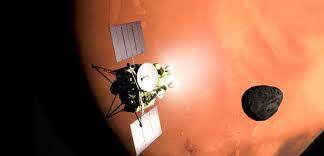30.05.2023

The Japan Aerospace Exploration Agency (JAXA) is working on an ambitious mission to explore two Martian moons, with a September 2024 launch planned, and it wants the Australian space sector to play a part.
The Martian Moons Exploration (MMX) program involves a five-year journey to learn more about the origins of the moons Phobos and Deimos and the evolution of the Martian sphere. JAXA says understanding the origins of this system is critical to understanding how planets formed in our Solar System.
At the recent 15th Andy Thomas Space Forum in Adelaide, JAXA Administrator Hiroshi Yamakawa said JAXA was excited about working with Australia on MMX. “As was the case with the Hayabusa mission, we hope to return the capsule containing samples from the Martian moon Phobos to the Woomera desert,” said Yamakawa. “We are very excited to work with the Australian space industry on this, and we appreciate your partnership.”
The successful landing of the Hayabusa capsule near Woomera in 2010 after a seven-year voyage is the template for the landing of the MMX sample return capsule in the same location, currently timed for mid-2029. The Hayabusa capsule contained soil samples from the asteroid Itokawa. The MMX capsule wants to bring back similar samples from Phobos.
“Mars is really at the gateway position between the inner part of the solar system and outer solar system,” Professor Masaki Fujimoto said while briefing an audience of Australian and international space industry professionals in Adelaide. “We don’t know about the origins of these moons, but we’ll get the samples back, learn more about the origins, and at that point, we can start to learn more about these edge regions between the inner and outer solar systems.”
The deputy director general of the Institute of Space and Astronautical Sciences at JAXA said it would take around one year to fly out to the Martian sphere. Once there, the spacecraft will spend about three years “cruising around the Martian system” before pivoting back towards Earth in 2028. Fujimoto says he cannot promise the landing will occur in 2029, noting that the recent failure of JAXA’s H3 launch vehicle may delay things, but he says the intention is to launch on time next year.
“We do plan to land in Woomera,” he said. “We already have a basic agreement in that direction, and that’s the plan. It’s a route for you (Australia) to become our international partner. We already have NASA, Germany, and the French contributing to the mission. I think that Australia is also fully entitled to be our international partner on this mission.”
JAXA and the ASA signed a space cooperation agreement in 2020, facilitating cooperation in peaceful space pursuits. Yamakawa says this agreement opens the way for the two countries to do more work together and to team up on bigger projects, such as NASA’s Artemis.
“I’m aware that the Australian Space Agency has plans to offer products and services that utilize the capabilities of the Australian space industry,” said Yamakawa. “As members of the first eight nations to sign the Artemis Accords, I’m encouraged that we will be engaged in future international space exploration with Australia.”
Quelle: SPACE&DEFENSE
